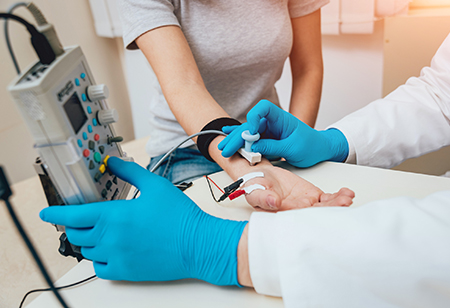Electromyogram (EMG)
An electromyogram (EMG) measures the electrical activity of your muscles when they’re active and when they’re at rest. The EMG assesses the health of your muscles and the nerves that control them.
Electromyogram tests include:
- Nerve conduction studies that use electrodes taped to your skin to show how well your body’s electrical signals are traveling along your nerves
- Needle EMG that uses a small, thin needle placed in several muscles to look at and listen to the electrical signals that travel from the needle to the EMG machine
EMG is a low-risk procedure with low risk of complications.

Why would my neurologist recommend an EMG?
Your physician might recommend an EMG to assess:
- Leg pain or numbness
- Nerves in your arms and legs
- Functioning of your spinal nerves
- Muscle or nerve dysfunction or problems with nerve-to-muscle signal transmission
An EMG also may be recommended if you have the following signs or symptoms that indicate a nerve or muscle disorder:
- Tingling
- Numbness
- Muscle weakness, pain or cramping
How do you prepare for an EMG?
Your HonorHealth neurologist conducting the EMG testing will want to know if you:
- Have a pacemaker or any other electrical medical device
- Take prescription blood-thinning medications or aspirin therapy
- Have hemophilia, a blood-clotting disorder that causes prolonged bleeding
Take a shower or bath before your exam to remove any oils from your skin. Don’t apply any lotions or creams after you’ve bathed. Other than that, you can eat, drive and exercise as usual before and after the testing.
What can you expect during an EMG?
When you arrive, you’ll probably be asked to change into a hospital gown and to lie down on an examination table.
Surface electrodes will be placed at various locations on your skin, depending on where you’re experiencing symptoms. During nerve conduction testing, you may experience a mild tingling sensation. If you’re having a needle EMG, your neurologist also may insert needle electrodes at sites related to your symptoms. These needle electrodes may cause discomfort or pain that will resolve once they’re removed. If pain is a concern, talk to your neurologist about taking short breaks throughout the testing.
Your neurologist will ask you to rest and contract various muscles at certain times. You also may change positions a few times. The testing generally lasts 20 to 40 minutes.
After the exam, you may have some minor bruising at the needle electrode sites. The bruising should fade within a few days.